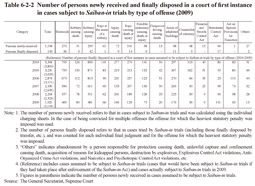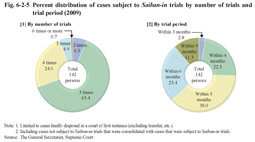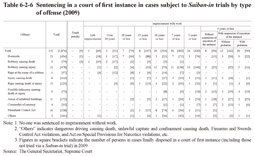2 Implementation status of Saiban-in system
Table 6-2-2 shows the number of persons newly received and finally disposed in a court of first instance in cases subject to Saiban-in trials (refers to cases that were subjected to Saiban-in trials) by type of offense in 2009. The number of persons newly received was the largest for robbery causing injury (295), followed by homicide (270), rape causing death or injury (101), and arson of inhabited buildings (98). The number of persons finally disposed was the largest for robbery causing injury (42), followed by homicide (36), Stimulants Control Act violations (17), and rape causing death or injury (14).
The number of persons finally disposed given in the table between 2004 and 2008 as reference material refers to cases that would have been subject to Saiban-in trials if they had taken place after enforcement of the Saiban-in Act (hereinafter referred to as “cases assumed to be subject to Saiban-in trials” in this subsection) whereas that in 2009 refers to cases subject to and cases assumed to be subject to Saiban-in trials.
Table 6-2-2 Number of persons newly received and finally disposed in a court of first instance in cases subject to Saiban-in trials by type of offense (2009)
Table 6-2-3 shows the number of persons newly received in a court of first instance in cases at district courts subject to Saiban-in trials and the Saiban-in selection rate based on that number in 2009. The Saiban-in selection rate refers to a number calculated by dividing the number of persons listed on the electoral register (the number provided by the Election Administration Commission in municipalities in response to inquiries from the respective courts) in the respective year by the number of persons newly received in cases subject to and cases assumed to be subject to Saiban-in trials and then by six (the number of Saiban-ins in principle). Approximately one person out of that number could have been selected as a Saiban-in if the Saiban-in Act had been enforced by January 1 the said year.
Table 6-2-3 Number of persons newly received in a court of first instance in cases subject to Saiban-in trials and Saiban-in selection rate by district court (2009)
Table 6-2-4 shows the status of the selection of Saiban-ins in cases subject to Saiban-in trials finally disposed in a court of first instance (excluding transfer, etc.) in 2009. The number of persons selected from the list of Saiban-in candidates and summoned on the date of the selection procedure (excluding those who had their summons cancelled) was 6,453, with 5,415 of them having actually appeared, and thus a percentage of (appearance ratio) 83.9%. The number of persons selected to be Saiban-ins, etc. was 1,210 and the percentage of persons on the list of Saiban-in candidates (selection rate) 0.4%.
Table 6-2-4 Selection status of Saiban-ins in cases subject to Saiban-in trials (2009)
Fig. 6-2-5 shows the percent distribution of cases subject to Saiban-in trials finally disposed in a court of first instance (excluding transfer, etc.) in 2009 by number of trials and trial period (period between new receipt and final disposition). A total of five or less trials took place in most cases, with cases in which trials were held three times or less accounting for 69.7%. The average number of trials was 3.3. Cases in which trial period was six months or less accounted for 88.7%, with the average trial period being 5.0 months (Source: The General Secretariat, Supreme Court).
Fig. 6-2-5 Percent distribution of cases subject to Saiban-in trials by number of trials and trial period (2009)
Table 6-2-6 shows the sentencing for persons convicted in a court of first instance in cases subject to Saiban-in trials in 2009 by type of offense.
Table 6-2-6 Sentencing in a court of first instance in cases subject to Saiban-in trials by type of offense (2009)




